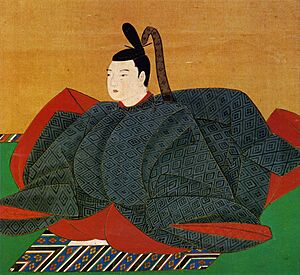Emperor Go-Kōmyō facts for kids
Quick facts for kids Emperor Go-Kōmyō後光明天皇 |
|||||
|---|---|---|---|---|---|

Go-Kōmyō by Otagi Michitomi
|
|||||
| Emperor of Japan | |||||
| Reign | November 14, 1643 – October 30, 1654 | ||||
| Coronation | December 2, 1643 | ||||
| Predecessor | Meishō | ||||
| Successor | Go-Sai | ||||
| Shōguns |
See list
Tokugawa Iemitsu
Tokugawa Ietsuna |
||||
| Born | Tsuguhito (紹仁) April 20, 1633 Tokugawa shogunate (now Japan) |
||||
| Died | October 30, 1654 (aged 21) Tokugawa shogunate |
||||
| Burial | Tsuki no wa no misasagi, Kyoto | ||||
| Spouse | Niwata Hideko | ||||
| Issue | Princess Takako | ||||
|
|||||
| House | Yamato | ||||
| Father | Emperor Go-Mizunoo | ||||
| Mother | Sono Mitsuko | ||||
Tsugihito (紹仁), later known as Emperor Go-Kōmyō (後光明天皇), was the 110th emperor of Japan. He was born on April 20, 1633, and passed away on October 30, 1654.
Emperor Go-Kōmyō ruled Japan from 1643 to 1654. He was an important leader during the 17th century. His name, Go-Kōmyō, means "Later Emperor Kōmyō." The word go- (後) in Japanese often means "later" or "second." This shows he was named after an earlier emperor, Emperor Kōmyō, who lived in the 14th century.
Contents
Family and Early Life
Before he became emperor, his personal name was Tsuguhito. He was also known by the title Suga-no-miya.
Tsuguhito was the fourth son of Emperor Go-Mizunoo. His mother was Fujiwara no Mitsuko. However, he was raised by Tōfuku-mon'in. His older half-sister, Empress Meishō, was the empress before him.
Emperor Go-Kōmyō lived in the Dairi part of the Heian Palace with his family. He had one daughter:
- Princess Takako (1650–1725). Her mother was Niwata Hideko, a lady-in-waiting. Princess Takako later became Empress Dowager Reiseimon’in.
Key Events During His Reign
Tsuguhito became the Crown Prince in 1641. He became emperor in 1643 when his sister, Empress Meishō, decided to step down. This is called abdication. After she abdicated, Tsuguhito officially took the throne. He was only 11 years old when he became emperor.
During his time as emperor, Japan was led by the powerful Tokugawa shogunate. The main leaders were Tokugawa Iemitsu and later Tokugawa Ietsuna.
Here are some important events from Emperor Go-Kōmyō's life:
- April 20, 1633: Tsuguhito, who would become Emperor Go-Kōmyō, was born.
- 1641: Prince Tsuguhito was chosen to be the next emperor and became the Crown Prince.
- 1643: Empress Meishō gave up her throne, and Tsuguhito became the new emperor.
- November 14, 1643: Go-Kōmyō officially became emperor. His reign began.
- 1645: The shōgun (military ruler) was given a higher rank.
- 1649: A large earthquake hit the city of Edo (now Tokyo).
- 1651: Tokugawa Ietsuna was named the new shōgun.
- 1652: A book called Nihon Ōdai Ichiran was first published in Kyoto. It was a history of Japanese emperors.
- 1653: A big fire destroyed much of the imperial palace and nearby temples in Kyoto. Some young girls were later held responsible for this and other fires.
- 1654: Ingen, a Buddhist priest from China, arrived in Japan. He wanted to bring new ideas to Buddhism in Japan.
- October 30, 1654: The emperor passed away. He was likely sick with smallpox. He was buried at Sennyū-ji temple.
Emperor Go-Kōmyō is honored at the imperial burial site called Tsuki no wa no misasagi at Sennyū-ji in Kyoto. Many other emperors and empresses are also buried there, including his father, Emperor Go-Mizunoo, and his sister, Empress Meishō.
Court Officials
The Kugyō (公卿) were a small group of very powerful men who worked for the Emperor of Japan. They were the most important officials in the court before the Meiji period. Even when the emperor's power outside the palace was small, these officials held high positions.
During Emperor Go-Kōmyō's reign, this group included:
- Sesshō (Regent): Nijō Yasumichi, Kujō Michifusa, Ichijō Akiyoshi
- Kampaku (Chief Advisor): Ichijō Akiyoshi, Konoe Hisatsugu, Nijō Mitsuhira
- Sadaijin (Minister of the Left)
- Udaijin (Minister of the Right)
- Naidaijin (Minister of the Center)
- Dainagon (Chief Counselor)
Eras of His Reign
In Japan, time is also marked by special periods called nengō or eras. Emperor Go-Kōmyō's reign included these eras:
See also
 In Spanish: Go-Kōmyō Tennō para niños
In Spanish: Go-Kōmyō Tennō para niños
- Imperial cult
| Regnal titles | ||
|---|---|---|
| Preceded by Empress Meishō |
Emperor of Japan: Go-Kōmyō 1643–1654 |
Succeeded by Emperor Go-Sai |

